Hydrogel is a common polymer that holds moisture well. The tool appeared on sale relatively recently, but immediately established itself on the best side. In today's article, we will consider how to use the hydrogel correctly, what you need to consider when buying, for what types of plants it is better to use it.
Material Content:
What is hydrogel
Hydrogel is a special polymer that is available in the form of granules or powder.
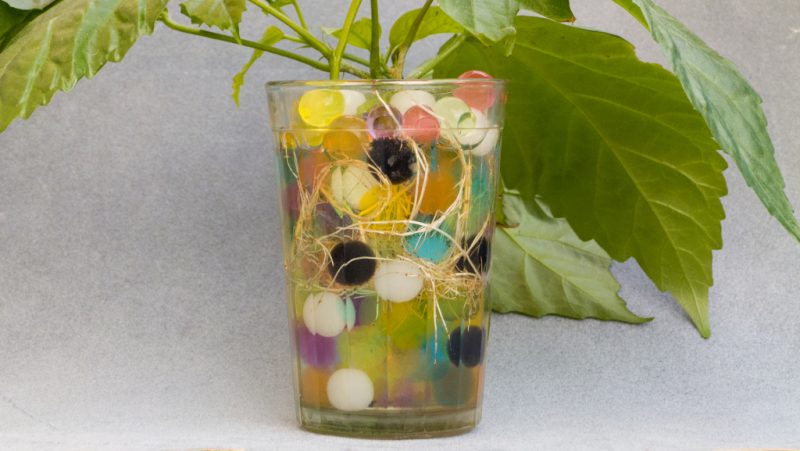
The tool has the following properties:
- It retains moisture that plants need.
- It keeps well fertilizers applied to the soil. Useful components are retained in granules for a long time, which allows plants to better absorb them.
- Improves soil structure.
- Protects soil from cracking.
- Speeds up the flowering and fruiting of plants.
Soft hydrogel is available in the form of a colorless powder or small colored granules. What is the principle of its work? When interacting with water, the product begins to swell, significantly increasing in size. Already swollen balls mix with the soil, the root system of plants begins to grow in them and is nourished by moisture.
Using a hydrogel allows you to completely dispense with watering for quite a long time (2 to 3 weeks). Of course, a lot depends on the root system of the plant - the thicker and stronger it is, the better the effect.
Balls remain in the soil for a long time (5 year life), after watering they swell again and continue to fully perform their functions.
It is worth noting that the use of a hydrogel protects the roots of plants from excess moisture. Thanks to this, you should not worry about their decay.
Several types of hydrogel can be distinguished:
- Soft. Widely used for indoor plants. Ideal for germinating seeds. Often used by gardeners when planting garden crops. Its advantage is that the granules are quite soft, the roots of any plant can freely penetrate the hydrogel and suck out moisture.
- Dense. In another way, this type of hydrogel is called aqua soil. The granules are multi-colored, some added sparkles and other decorations. The main task is decorating vases and pots with plants.
Hydrogel has been widely used in floriculture and horticulture, having established itself only on the positive side.
The chemical composition of the hydrogel
Many gardeners are concerned about the question of whether it is dangerous to use a hydrogel for flowers and plants. Experts say that it is not toxic and consists of chemically harmless substances.

All its components, after the expiration of the operating life, are independently broken down, turning into organics.
Hydrogel is absolutely safe for plants and not toxic to humans.
What plants use hydrogel
Hydrogel is ideal for indoor plants. It absorbs and retains moisture well. So, 1 g of the product can easily hold up to 200 - 400 g of liquid, which will subsequently be gradually given to the root system.
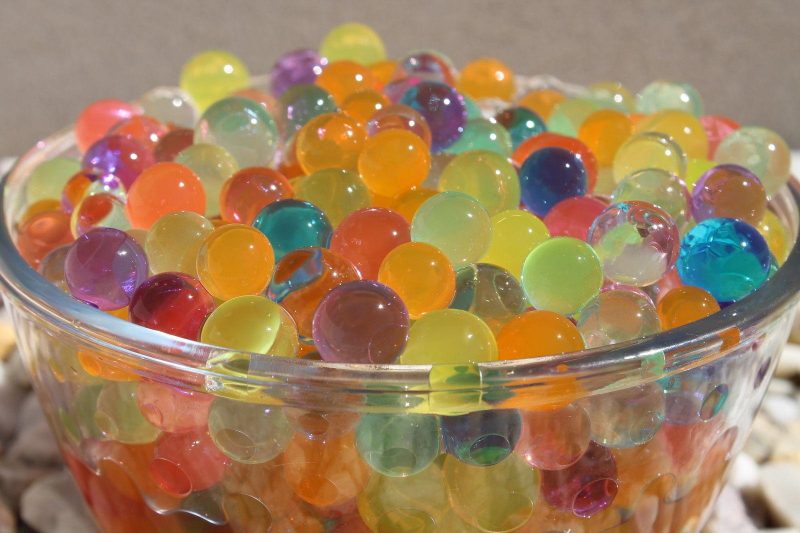
Hydrogel can also be used in open or closed ground. The tool is recommended to be made when planting trees, shrubs, flower beds. In these cases, the number of irrigations is significantly reduced.
Hydrogel is also widely used in seedling cultivation. Nutrient components are added to the irrigation liquid, which contributes to the early growth of the plant and the strengthening of the root system.
Many flower growers use hydrogel beads exclusively for decorative purposes, confusing them with water soil. It is not right.
The main objective of the product is to provide the plant with the necessary amount of fluid and prevent the soil from drying out.
Instructions for use
When thinking about how to use a hydrogel for plants, first of all pay attention to what soil will be planted. An important role is played by the form of the root system of the green pet, and many other factors that are worth exploring in more detail.
How to use for indoor plants
Hydrogel for indoor plants, which are planted in flowerpots and pots, is used quite often. For this purpose, it is better to use ready-made, swollen granules. To do this, the product should be soaked in standing water for 1 hour, drain the excess liquid, then mix the granules with the soil and plant a flower.
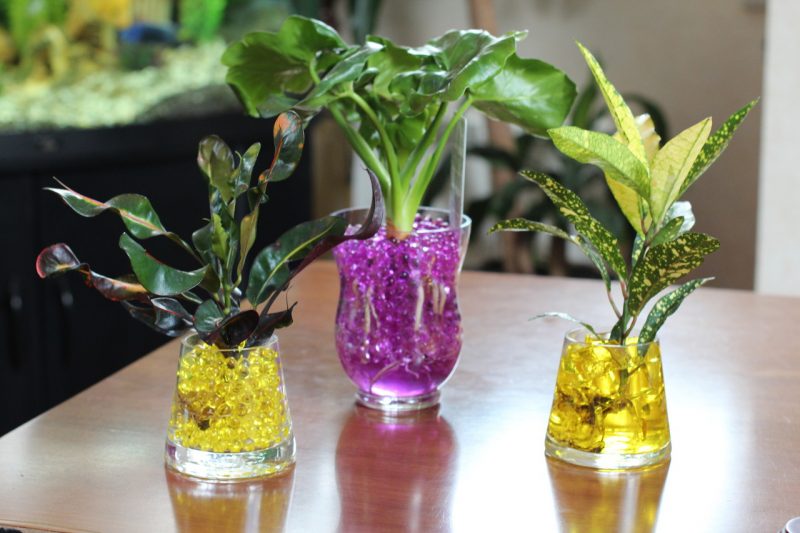
It is very important to distribute the hydrogel evenly so that there are no areas without capsules.
If you have already planted a flower in the soil and want to add a hydrogel to it, proceed as follows:
- On the surface of the soil, make holes that will reach the root system of the flower. Do this carefully, not with a sharp object, so as not to damage the plant.
- Pour the hydrogel into the formed holes. It is important that the capsules are dry, not saturated with moisture.
- Water the plant abundantly.
- Capsules should then increase in size. If there are too many of them, and they are visible on the surface of the soil, be sure to remove the excess and sprinkle them with soil.
Some types of flowers can be grown only in hydrogel. In this case, the granules are soaked in solution with mineral fertilizers.
Using hydrogel for flowers without adding soil, the following points should be considered:
- Watering is best done with settled water. This eliminates the formation of plaque and moss on the surface of the granules, as well as the appearance of bacteria and pests.
- If the plant has too developed a root system, it will "creep" into the pot and it will not look very beautiful.
- Some colors lack oxygen, so in some cases you can’t do without adding soil.
If you still have unused hydrogel, be sure to put it in an airtight container and put it in the refrigerator on the middle shelf.
For seedlings
Hydrogel is often applied to open ground. In this case, watering is reduced to 2 times a week. Agree, a very convenient way, if there is no way to often take care of the garden plot.

Instructions for use are as follows:
- pour water on the product;
- dig the soil, prepare the holes for planting seedlings;
- put the granules in the wells, mix with the soil;
- set a seedling and sprinkle with soil mixed with hydrogel.
How much money should I deposit? The calculation is as follows: 100 g of granules per 1 square. m of soil.
Using a hydrogel for seedlings, it is important to pay attention to the root system of plants. If it is superficial, the admissible depth of granules should not exceed 10 cm. In other cases, this value can fluctuate within 25 cm.
In a hydrogel, seeds can also be germinated. It is enough to put them in the product, moisten a little and water in a timely manner.
Pros and Cons of Using a Hydrogel
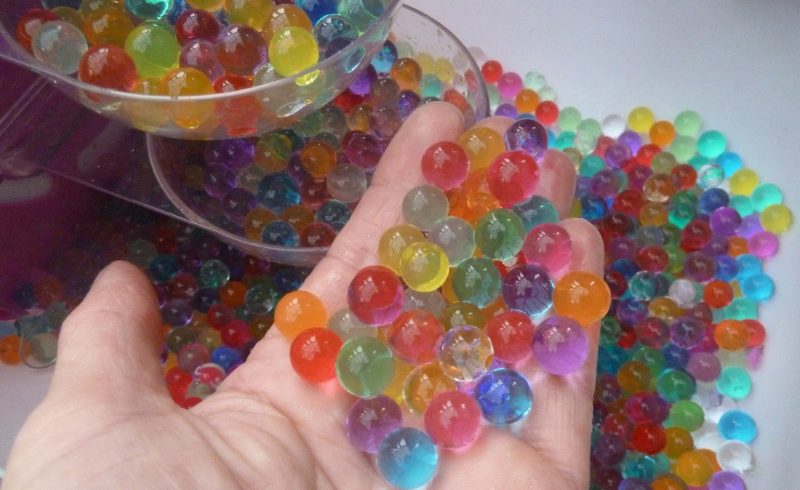
Among the strengths of using a hydrogel are the following:
- the product retains moisture and nutrients for a long time, gradually distributing them along the root system of the plant;
- allows you to quickly germinate the seeds without much care for them;
- prevents stagnation of fluid in the soil and decay of the root system;
- granules are completely safe for plants and humans;
- You can not worry about constant watering of the plant;
- does not allow fertilizers to be washed out of the soil;
- granules have a beautiful aesthetic appearance.
But there are a number of disadvantages, among which the following can be distinguished:
- Not suitable for all seeds and plants. If the root system of the flower is too massive, it will be difficult for her to penetrate the hydrogel. The same applies to seeds with a leathery shell (for example, sweet peas).
- The service life of the granules is 5 years. But in practice, this period is reduced to 1.5 years. After this, the granules retain moisture much worse, can darken, wrinkle.
- On the surface of the granules, bacteria can form that infect the plant.
A significant disadvantage for many is the high cost of hydrogel. So 10 kg of the product will cost 6,000 - 6,500 rubles.
Hydrogel and aquagrunt - what is the difference
It's time to sort it out and find the differences between the aquagrunt and the hydrogel. Many people think that this is one and the same remedy. But experts say that this is far from the case.
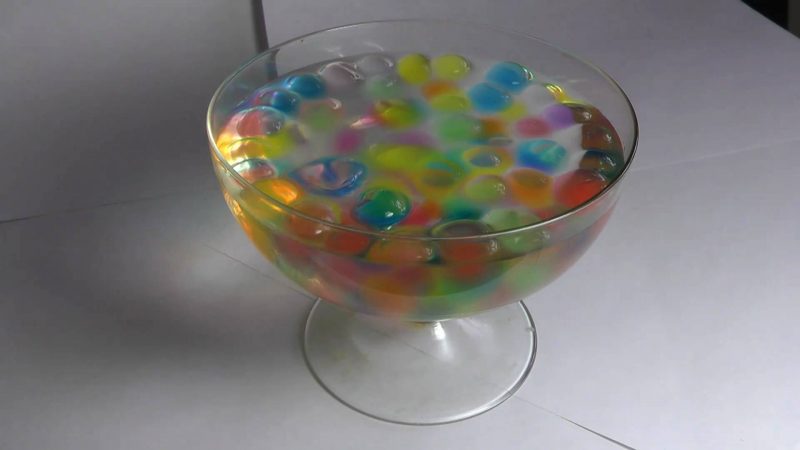
An aqua soil is used only for decorative purposes. If watering is reduced, the plant will die.
What are the differences between the hydrogel and hydrogel:
- the product does not decompose;
- granules are colored, sometimes with the addition of sparkles and rhinestones;
- issued in the form of stars, rhombuses, other geometric shapes;
- has an attractive pricing policy;
- can only be used for decorative purposes.
Hydrogel - know-how in floriculture and gardening. This tool greatly facilitates summer residents care of plants. The number of irrigations is reduced to several times a week. Flowers with an underdeveloped root system can completely dispense with watering for up to 2 to 3 weeks.
It is important not to confuse the hydrogel with aqua soil. These tools perform completely different functions. The task of aqua soil is to give an aesthetic appearance to a flowerpot with a plant. These balls have nothing to do with hydration.












